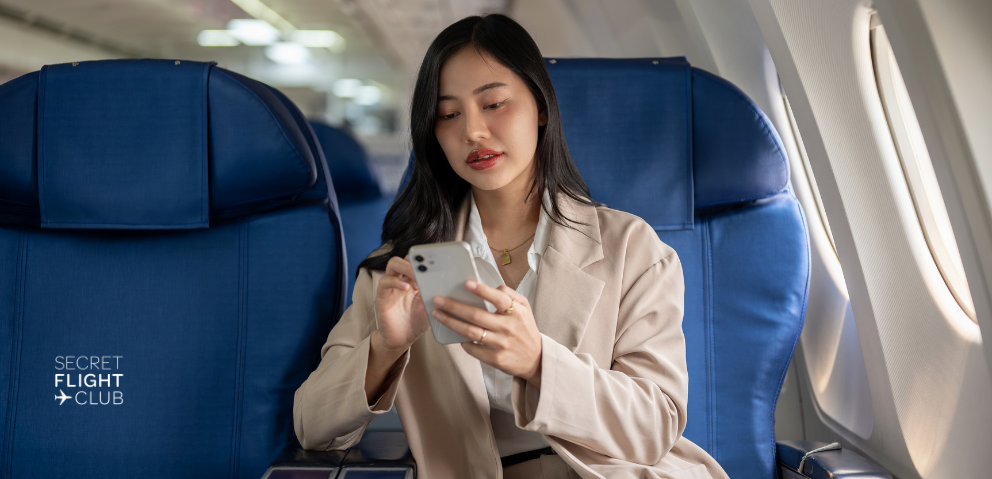What Really Happens If You Don't Turn On Airplane Mode During a Flight?
09 September 2024

Ever wondered what happens if you don't turn on airplane mode during a flight? It's a question that's crossed many travellers' minds as they settle into their seats, phone in hand. While you might be tempted to keep scrolling through social media or sending last-minute texts, there's more to this little button than meets the eye. Airplane mode isn't just a pesky rule – it's a crucial safety measure that has an impact on both your device and the aircraft's systems.
As you prepare to take off, you'll discover why you have to use airplane mode and whether airplane mode is necessary. We'll explore the science behind this feature, delve into safety concerns, and examine how 5G technology in aviation is shaking things up in air travel. You'll also learn about your responsibilities as a passenger and the proper etiquette to follow. So buckle up and get ready to uncover the truth about what happens when you don't use plane mode– it might just surprise you!
The Science Behind Airplane Mode
Ever wondered why your phone goes into a digital sulk when you switch on airplane mode? Let's dive into the tech tango that happens between your gadgets and the aircraft's systems.
How mobile phones communicate with towers
Your trusty mobile phone is quite the chatterbox. It's constantly chatting away with nearby cell towers, even when you're not using it. This digital dialogue happens through radio waves, which are like invisible gossip lines in the air. When you're cruising at 30,000 feet, your phone gets a bit shouty, cranking up its signal to maximum power to maintain its long-distance relationship with ground-based mobile networks.
Electromagnetic interference explained
Now, here's where things get a bit sticky. All those chatty devices create a buzz of electromagnetic interference (EMI). It's like having a rowdy party next door when you're trying to have a quiet night in. This EMI can potentially mess with the aircraft's sensitive electronic systems, causing them to get their wires crossed, so to speak. This is why you are not allowed to use your phone on a plane without airplane mode enabled.
Aircraft communication systems
Planes are pretty tech-savvy these days. They use a variety of radiofrequency bands to chat with air traffic control, satellite connections, and other aircrafts. These systems are designed to be tough cookies, able to handle a certain amount of electromagnetic noise. But just like you might struggle to hear your friend in a noisy pub, too much interference can make it hard for these systems to do their job properly, impacting an aircraft maintenance and operational efficiency.
So, when you switch on airplane mode, you're essentially telling your device to pipe down and behave itself. It's like putting your phone in a digital time-out, ensuring it doesn't cause any mischief with the plane's crucial communication and navigation systems. After all, we want our pilots to hear "clear for landing" not "sorry, can you repeat that?"
Safety Concerns and Regulatory Measures
FAA and FCC regulations
You might think the sky's the limit when it comes to using your mobile phone on a plane, but the Federal Communications Commission (FCC) begs to differ. They've put the kibosh on using mobile phones aboard aircraft in flight. But here's a plot twist: the Federal Aviation Administration (FAA) isn't actually the one wagging their finger at you. They've tossed the hot potato to the airlines, letting them decide if your gadgets are friend or foe to their systems.
Pilot perspectives on mobile device use
Now, you might be wondering if pilots get to bend the rules. Well, sorry to burst your bubble, but they're in the same boat – or should we say, plane – as you are. The FAA has put their foot down on pilots using electronic devices during all phases of flight. It's a bit like telling a chef they can't use their favourite spoon – it's all about safety, folks!
Incidents related to phone interference
Here's where things get a bit hairy. There have been some hair-raising incidents where mobile phones have been the suspected culprits of avionics gone wild. We're talking false alarms, distracted pilots, and passenger communications hiccups. It's like your phone is throwing a digital tantrum at 30,000 feet! While the jury's still out on whether your tiny device can really cause big trouble, the powers that be reckon it's better to be safe than sorry. So next time you're tempted to sneak a cheeky text mid-flight, remember: your Instagram update can wait, but a safe landing can't!
The Impact of 5G Technology on Air Travel
Hold onto your seat belts, folks! The 5G revolution is taking off, and it's set to shake up the world of air travel. But before you start dreaming of high-speed inflight Wi-Fi at 30,000 feet, there's a bit of turbulence to navigate.
5G networks and aircraft altimeters
Picture this: your plane's altimeter signals and a 5G tower having a shouting match. That's the concern keeping aviation bigwigs up at night. You see, these critical instruments use radio waves to measure a plane's height, and they're nestled cosily next to the 5G spectrum. It's like trying to have a quiet chat while your neighbour's throwing a rock concert next door.
Differences between EU and US 5G implementation
Now, here's where things get interesting. The EU and US are taking different approaches to this 5G conundrum. It's like they're playing the same game but with different rulebooks. The US has been a bit more gung-ho, leading to some nail-biting moments for the FAA and FCC. Meanwhile, the EU's taking a more cautious route, keeping those 5G signals on a tighter leash near airports, with stricter EU regulations in place.
Future of in-flight connectivity
But it's not all doom and gloom! Once we've ironed out these kinks, 5G promises to revolutionise your in-flight experience. Imagine streaming services without buffering, or video calling your loved ones with crystal-clear clarity and low latency. The future of air travel is looking mighty connected, with air-to-ground connectivity, personalized services, and smart airports on the horizon. It's coming in for landing sooner than you think!
Passenger Responsibilities and Etiquette
Following crew instructions
You've heard it a thousand times, but let's face it: those in-flight safety instructions are more than just a pre-take off lullaby. They're your ticket to a smooth and safe journey. So, next time you're tempted to tune out, remember: those friendly flight operators in uniform aren't just there to serve you pretzels and tiny bottles of wine.
Take-offs and landings are the aerial equivalent of a rollercoaster ride – thrilling, but potentially dicey. That's why you'll find yourself playing musical chairs with your seat position and window shades. It's not just about mood lighting; it's about being ready for anything. And speaking of being ready, keep your mobile on airplane mode. Your Instagram followers can wait, but the plane's navigation systems? Not so much.
Consequences of non-compliance
Now, you might think you're being clever by sneaking in a quick text during taxi, but here's a newsflash: that "one quick message" could land you in hot water faster than you can say "turbulence". If you decide to play rebel without a cause, you might find yourself starring in an impromptu episode of "Passenger Gets Escorted Off Plane". Trust us, it's not the kind of viral fame you want.
Balancing connectivity and courtesy
Let's be honest, we're all itching to stay connected. But remember, your desire to tweet about the questionable in-flight meal choices shouldn't trump the pilot's need for clear communication. Think of airplane mode as your good traveller badge – it shows you're a team player, even if the team is a bunch of strangers crammed into a metal tube hurtling through the sky. Plus, you'll avoid any pesky roaming charges while in the air!
Conclusion
The world of air travel is constantly evolving, with new technologies bringing both opportunities and challenges. As we've seen, the simple act of turning on airplane mode has a significant impact on flight safety and communication systems. It's not just about following rules, but about being a responsible traveller and ensuring a smooth journey for everyone on board.
Looking ahead, the rollout of 5G networks is set to shake things up in the aviation industry. While it promises to improve cellular connectivity and the passenger experience with infotainment features, it also brings new hurdles to overcome, like potential interference with aircraft systems. Regulatory bodies like the European Union Aviation Safety Agency are working to ensure a safe and seamless integration of 5G in the skies.
As passengers, our role is to stay informed, follow crew instructions, and strike a balance between staying connected and being courteous to our fellow travellers. In the end, a safe and pleasant flight experience depends on everyone doing their part, from ground operations to in-flight cooperation. So next time you're jetting off, remember: airplane mode is more than just a button – it's your ticket to a smooth, safe, and enjoyable journey in the friendly skies.
FAQs
What occurs if I don't switch to airplane mode during a flight?
While there has never been a recorded incident of a plane crash directly caused by a phone not being in airplane mode, it is still considered courteous to switch to airplane mode to avoid potential interference with the aircraft's systems. It's a precautionary measure to ensure there are no distractions from such interference.
Is it essential to activate airplane mode while on an airplane?
Yes, one of the key reasons for enabling airplane mode is to prevent any electronic interference with the plane's navigation and communication systems, ensuring a safe and interference-free flight environment.
Can you use 4G on a plane? Does 4G work on planes?
No, you cannot use 4G or mobile data on a plane. Cellular networks are not designed to work at high altitudes and speeds, so your phone will not be able to connect to any ground-based cell towers while in flight.
Can you use data on a plane?
No, you cannot use cellular data on a plane. However, some airlines offer in-flight Wi-Fi services that allow you to connect to the internet using the plane's satellite connection, for a fee.
Does Sky have 5G? What about Sky 5G SIM?
Sky, a British telecommunications company, does offer 5G services in select areas across the UK. They provide 5G-compatible SIM cards for customers with 5G-enabled devices. However, these services are not currently available for in-flight use.
How many phones can I take on a plane?
There is no specific limit to the number of phones you can bring on a plane, but all devices must be switched to airplane mode during the flight. It's also important to follow the airline's guidelines for lithium battery safety and pack your devices properly in your carry-on or checked luggage.
Do mobile phones truly interfere with aircraft operations?
Yes, the radio waves emitted by certain electronic devices, including mobile phones, can potentially affect the aircraft's navigation tools, communication with ground control, and other critical collision avoidance technologies.
Could I be removed from a flight for not setting my phone to airplane mode?
While there's no direct safety issue that mandates switching your phone to airplane mode, failure to comply with crew instructions, including requests to switch devices to airplane mode, can lead to being removed from the flight. It's important to follow the crew's guidance to avoid any issues during the flight

